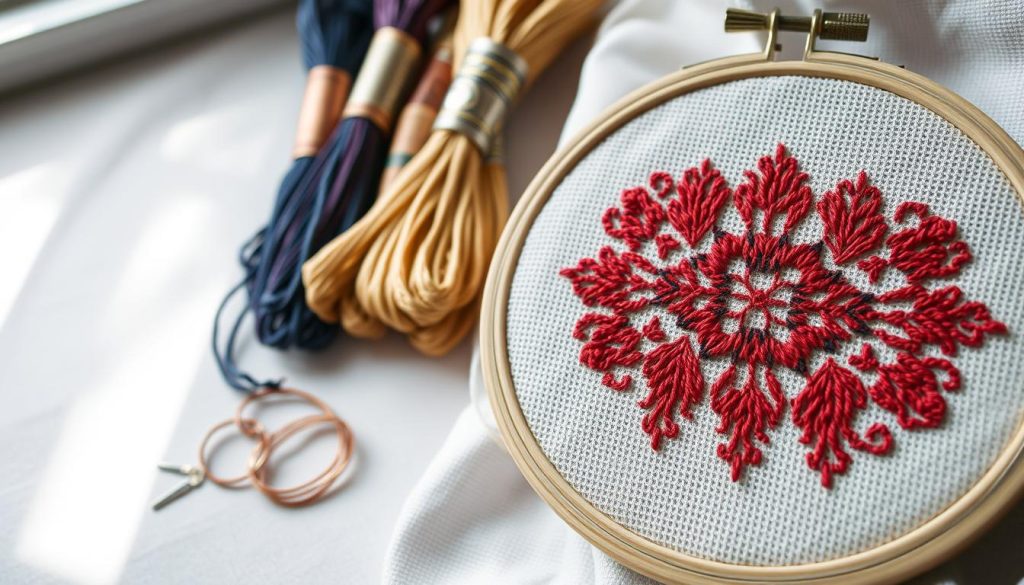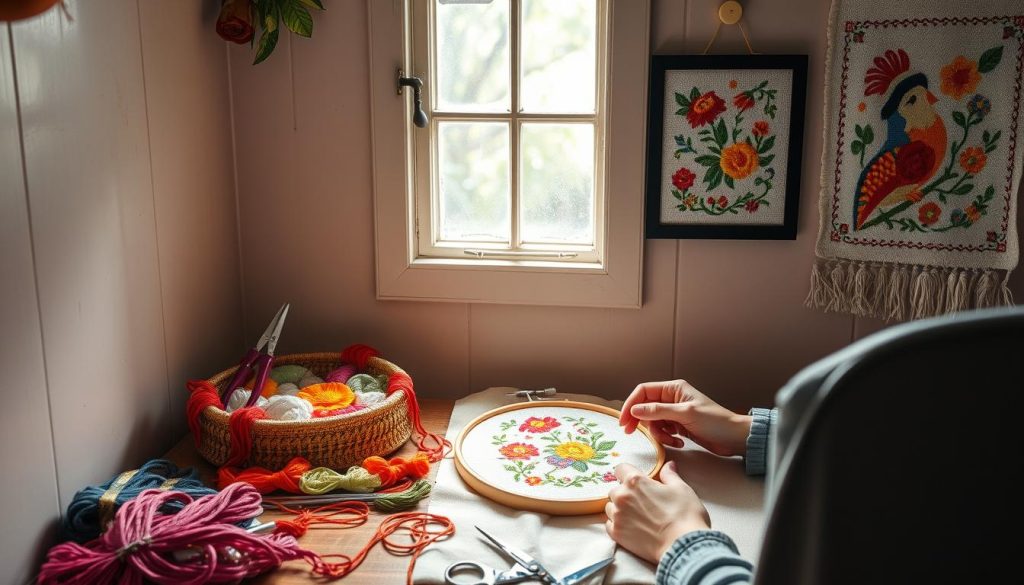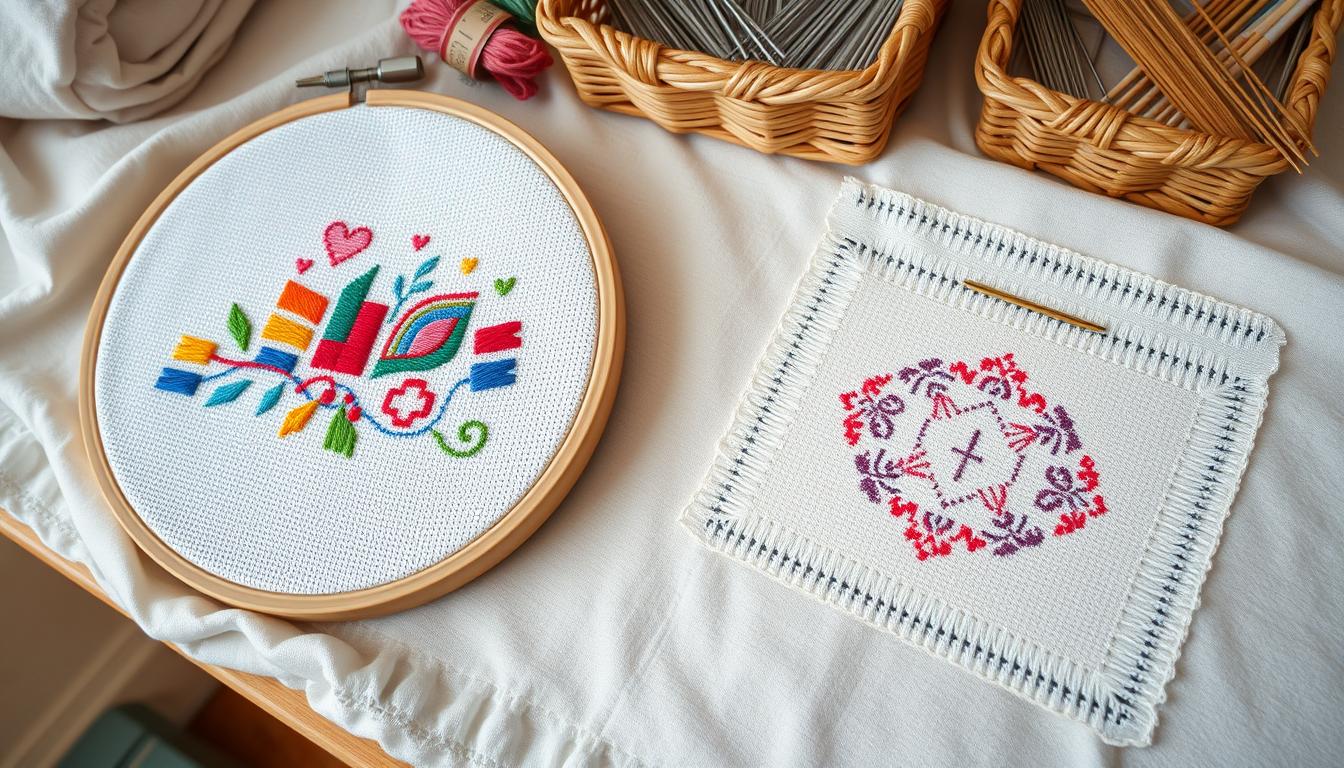Many crafters aim to make their cross stitch look professional. It takes practice and the right tools. This guide will share key tips and techniques to improve your stitching.
Starting your cross stitch journey right is important. The quality of your materials greatly affects your work. It’s not just threads and fabric, but also tools and accessories. Learning advanced techniques and practicing will make your work better.
Key Takeaways
- Selecting high-quality materials is crucial for a professional look.
- Mastering your stitching techniques ensures neater and more precise stitches.
- Managing thread tension and coverage is key to a consistent finish.
- Advanced techniques like railroading can enhance the neatness of your work.
- Practicing and integrating into cross stitch communities leads to continual improvement.
Choosing the Right Materials
The key to a professional-looking cross stitch project is choosing the right materials. High-quality fabric, threads, needles, and supplies are crucial. They help achieve the best results and make stitching more enjoyable.
Selecting Quality Cross Stitch Fabric
The right fabric greatly affects your project’s look. 100% cotton Aida fabric is the top choice, with counts like 14, 16, and 18. It suits all skill levels.
Evenweave fabric, with counts like 28 and 32, offers a smooth texture. It’s perfect for advanced patterns. Linen fabric gives a natural, vintage look but may have uneven thread thickness.
Choosing quality fabric is the first step to a professional cross stitch. Whether it’s Aida, evenweave, or linen, it sets the foundation.
Best Cross Stitch Threads and Needles
Quality threads and needles are key for neat and durable stitching. DMC mouline, glow in the dark, etoile, and metallic floss are popular choices. Tapestry needles, with their blunt ends, work well with different fabric counts.
Gold-plated needles are durable and recommended. Make sure your threads and needles match your fabric for an even look.
Essential Cross Stitch Tools and Accessories
Investing in essential supplies enhances your stitching. Use embroidery scissors with short, sharp blades to cut floss without damaging fabric. Hoops from 4-8 inches keep fabric taut while stitching.
Tools like beeswax, needle threaders, and project bags prevent common issues. Magnetic needle minders keep needles safe and secure, with over 24 designs available at promotional prices.
| Fabric Type | Common Counts | Pros | Cons |
|---|---|---|---|
| Aida | 14, 16, 18 | Easy to use | Stiffer texture |
| Evenweave | 25, 28, 32 | Smooth texture | Requires more counting |
| Linen | 28, 32 | Vintage look | Uneven thread thickness |
By carefully choosing the right fabric, threads, needles, and supplies, you can create a beautiful and professional-looking cross stitch project.
Perfecting Your Stitching Techniques
Learning different cross stitching methods can really improve your work. Let’s explore some popular techniques to make your stitching better. You’ll get professional results every time.
Learning the Danish Method
The Danish method is loved by many for its efficiency. It means you finish the first part of each stitch in a row before doing the second. This keeps your stitches even and polished.
This method is great for big projects, especially those on Aida fabric counts of 14 or higher.

Understanding the English or Victorian Method
The English method, also known as the Victorian method, is about making each stitch one at a time. It’s perfect for designs with lots of color changes. But, it can look messy if not done carefully.
To keep it neat, use top-quality threads like DMC. They make your stitches look smoother. This method is good for big projects where color blending matters.
Utilizing the Loop Method
The loop method is great for starting without loose ends. It helps keep your stitches consistent, making them cleaner and more professional. It’s perfect for beginners, especially with kids’ cross stitch kits.
Using the loop method from the start helps you learn other techniques better. It’s a solid foundation for mastering cross stitching.
Mastering Tension and Coverage
To improve your cross stitch, focus on thread tension and full coverage. These are key to a polished finish. Whether you’re new or experienced, these tips will help you grow.
Managing Thread Tension
Thread tension is crucial in cross stitch. The right tension keeps your fabric smooth and stitches even. Tools like Q-Snaps help manage tension better.
- Consistent top stitches should always face the same direction for a cleaner appearance.
- Even tension helps in reflecting light uniformly across your piece.
- Railroading aligns two strands of floss side by side for flatter stitches and even coverage.
Achieving Full Coverage
Full coverage is key for a vibrant piece. Each stitch leg should go in the same direction for a uniform look. This is especially important on lower count fabrics.
Techniques like railroading improve coverage. It keeps threads aligned and prevents twists. It’s great for metallic threads. Here’s how to get full coverage and even tension:
| Technique | Benefit | Recommendations |
|---|---|---|
| Railroading | Smoother surface, less twisting | Effective with two threads, use laying tools |
| Laying Tools | Consistent tension | Practice on spare fabric |
| Q-Snaps | Firm fabric hold | Use for large projects |
By mastering these techniques, your cross stitch will look professional and artistic. Focus on thread tension and full coverage to improve your craft.
Advanced Cross Stitch Techniques
Exploring advanced cross stitch techniques can really improve your work. Using a laying tool and mastering railroading can make your stitches look neat and professional.
Utilizing a Laying Tool
The laying tool is key in advanced cross stitch. It makes sure each thread is parallel to its neighbor. This tool keeps tension even, leading to smooth stitches.
It also stops threads from tangling. This makes your cross stitch look better.
Railroading for Neater Stitches
The railroading technique makes your stitches look even neater. It involves keeping each thread separate and flat as you stitch. This creates a clean, refined look.
It might take more time, but it’s worth it. Your work will look like fine art.
Using these advanced techniques with what you already know can make a big difference. Try using the laying tool and railroading technique more. You’ll see your work become more detailed and beautiful.
| Specialty Stitch | Designer Known For |
|---|---|
| Lazy Daisies | FabyReilly |
| Smyrna Cross / Double Cross | Victoria Sampler |
| Algerian Eyelet | Teresa Wentzler |
| Diamond Eyelet | Chatelaine |
| Rhodes Stitch / Rhodes Heart | Shannon Christine |
| Jessica Stitch | Chatelaine |
Finishing Techniques That Make a Difference
Finishing your cross stitch project is more than just stitching. Washing, ironing, and framing are key steps to make it look professional and last long. Let’s explore the best ways to do these important steps.
Proper Washing and Ironing of Your Work
After stitching, cleaning your work is crucial. *Washing cross stitch* helps prevent color changes. Use lukewarm water and a mild detergent. Let it soak gently without wringing or scrubbing.
Then, *ironing cross stitch* is vital to remove wrinkles. Place the damp piece face down on a towel, cover it, and iron gently. This keeps your stitches intact and gives a clean look.
Framing Your Cross Stitch Art
*Framing cross stitch* makes it look better and keeps it safe. Start with acid-free materials to avoid damage. Use sewing thread to mount your piece for better durability.
Here are some tips:
- Foam Board: It’s light and easy to handle, great for backing.
- Sticky Board with Lightweight Batting: Adds a soft cushion.
- Upcycled Materials: Old frames can be reused for a unique look.
Before framing, you might need to block the fabric. Use blocking mats to straighten it. When framing, avoid pressing too hard to keep stitches from flattening.
Finishing touches can include creative ideas like canvas frames or mug cozies. Each method has its own way to make your project look great.
By *washing cross stitch*, *ironing cross stitch*, and *framing cross stitch* carefully, your artwork is ready to be displayed. These steps make your project stand out and last for years.
The Importance of Practice
Regular cross stitch practice is key to improving your skills. Trying different techniques and materials boosts your creativity and challenges you to grow. This helps you achieve professional-looking results.
Practicing Different Stitching Techniques
Experimenting with various stitching methods is very beneficial. The Danish Method, the English or Victorian Method, and the Loop Method each have unique benefits. By practicing regularly, you can find the best techniques for your projects, enhancing your work’s quality.
Joining Cross Stitch Communities
Being part of cross stitch communities offers more than just friendship. These groups share knowledge and inspiration. Online forums, for example, provide advice, pattern ideas, and feedback from experienced stitchers.
These communities also boost your motivation and creativity. Cross stitch is known to help with mental health, fighting depression and giving a sense of purpose. It can also distract from unhealthy habits, keeping your mind focused.

- Feedback and Critique: Constructive feedback improves your technique.
- Shared Resources: Access to patterns, tools, and material recommendations.
- Motivation: Staying connected with fellow enthusiasts keeps you inspired.
Starting is easy and affordable, with small kits around £15. Cross stitch is a skill that can be quickly learned and passed down through generations. However, remember to take breaks and check your posture to avoid discomfort. The calming nature of cross stitch also promotes mindfulness and tranquility.
| Benefit | Result |
|---|---|
| Mental Health | Combats depression, provides a sense of purpose |
| Focus | Distraction from unhealthy habits |
| Affordability | Kits cost around £15 |
| Generational Skill | Connects individuals to their heritage |
| Ease of Learning | Quickly learned and mastered |
| Meditative State | Induces calm and tranquility |
| Mindfulness | Achieving a flow state |
Conclusion
Starting a perfect cross stitch project is more than just threading a needle. It’s about choosing the right materials and mastering stitching techniques. High-quality Aida fabric, embroidery floss, and a detailed pattern are key. These elements ensure your work looks great and is technically sound.
Keeping thread tension right and covering the fabric fully is essential. Learning advanced techniques, like using a laying tool, can make your work stand out. Finishing touches like washing, ironing, and framing add to the beauty of your piece. The colors you choose also play a big role in the final look, adding depth and vibrancy.
Practice is key to becoming a master of cross stitch. Regular practice and joining cross stitch communities help you learn and get inspired. These groups are great for sharing tips, getting advice, and staying motivated. Many find cross stitching calming and fulfilling, boosting mental health and creativity.
The path to perfect cross stitch combines skill, patience, and a love for learning. It’s not just about creating something beautiful but also about feeling a sense of pride and belonging. By focusing on these aspects and improving your skills, you’ll create stunning cross stitch art that showcases your talent.
